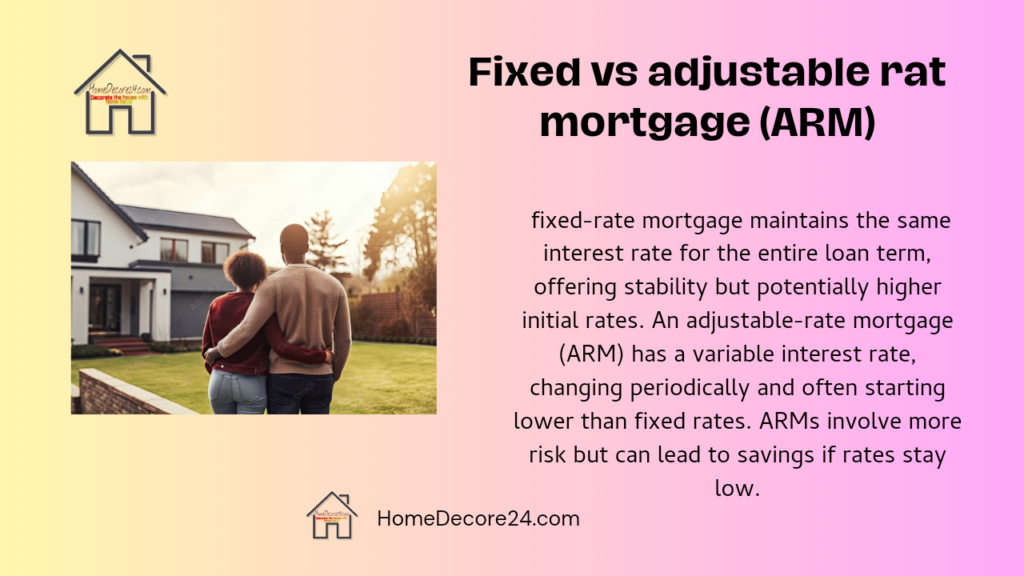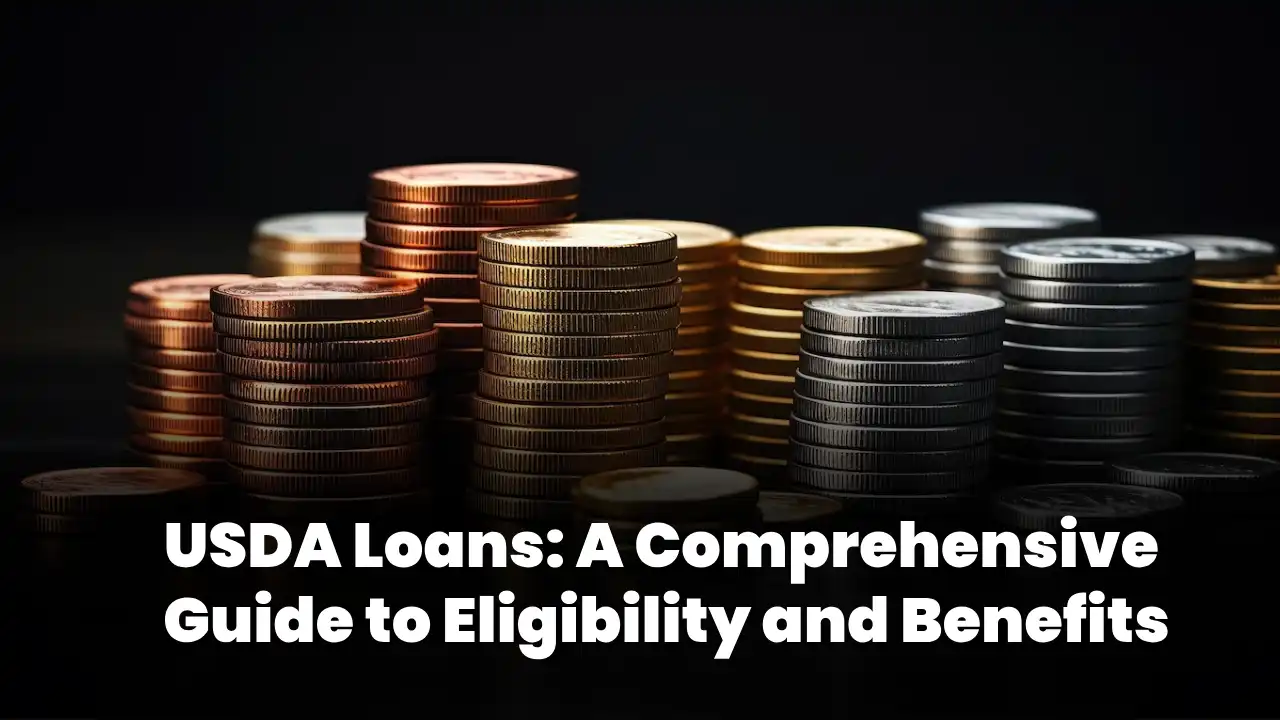
In the realm of mortgage financing, individuals seeking to purchase a home or refinance an existing property often encounter a crucial decision: whether to opt for a fixed-rate mortgage or an adjustable-rate mortgage (ARM).
These two distinct mortgage types present varying advantages and considerations, making it essential for potential homeowners to thoroughly understand their differences before making an informed choice. The choice between a fixed-rate mortgage and an ARM can significantly impact a borrower’s financial stability and planning over the life of the loan.
In this discussion, we will delve into the key disparities between these two mortgage options, shedding light on their respective mechanics, potential benefits, and potential drawbacks. By the end, readers will be better equipped to make a mortgage decision that aligns with their long-term financial goals and risk tolerance.
“fixed-rate mortgage maintains the same interest rate for the entire loan term, offering stability but potentially higher initial rates. An adjustable-rate mortgage (ARM) has a variable interest rate, changing periodically and often starting lower than fixed rates. ARMs involve more risk but can lead to savings if rates stay low.”
Overview: ARM vs. fixed-rate mortgage
When considering a mortgage, borrowers often face the decision between an Adjustable-Rate Mortgage (ARM) and a Fixed-Rate Mortgage. The primary distinction lies in how interest rates are structured. A Fixed-Rate Mortgage maintains a consistent interest rate throughout the loan term, providing predictability but potentially higher initial rates.
On the other hand, an ARM offers an initial fixed-rate period, after which the interest rate adjusts periodically based on prevailing market rates. ARMs can offer lower initial rates but carry the risk of rate fluctuations. The choice between these options hinges on an individual’s risk tolerance, financial goals, and market outlook.
Read More: Prenuptial Agreements and Mortgages
What are the differences between fixed-and adjustable-rate mortgage?
Fixed-rate mortgages and adjustable-rate mortgages (ARMs) differ primarily in how the interest rate is structured over the life of the loan. A fixed-rate mortgage maintains a constant interest rate from start to finish, ensuring that monthly payments remain steady. This predictability can provide stability and make long-term budgeting more manageable. However, fixed-rate mortgages often come with slightly higher initial interest rates compared to the initial rates of ARMs.
In contrast, an ARM offers an initial fixed-rate period, typically ranging from 3 to 10 years. During this period, the interest rate remains unchanged, often resulting in lower initial monthly payments compared to fixed-rate mortgages.
After the initial period, the interest rate adjusts periodically, usually once a year, based on a benchmark interest rate, such as the U.S. Prime Rate or the London Interbank Offered Rate (LIBOR). These adjustments can lead to fluctuations in monthly payments, making long-term financial planning more challenging.
While fixed-rate mortgages provide stability but might have higher upfront costs, ARMs can offer lower initial payments but carry the risk of payment fluctuations over time. Choosing between the two depends on factors like the borrower’s risk tolerance, financial goals, and market expectations. Those seeking steady payments and a long-term perspective often opt for fixed-rate mortgages, whereas individuals planning to sell or refinance before the ARM’s adjustment period might find them more suitable.
How are ARM and fixed-rate mortgages similar?
Both fixed-rate mortgages and adjustable-rate mortgages (ARMs) are lending options designed to facilitate home ownership, but they exhibit similarities in some key aspects. Both mortgage types serve as means for individuals to secure funds for purchasing a home, allowing borrowers to spread the cost over an extended period while gaining ownership upfront.
Both fixed-rate mortgages and ARMs require borrowers to make regular monthly payments that contribute towards repaying the principal amount borrowed and the interest accrued. Additionally, both mortgage types involve the consideration of factors such as the borrower’s creditworthiness, loan amount, and down payment.
Furthermore, fixed-rate mortgages and ARMs offer borrowers the opportunity to deduct mortgage interest payments from their taxable income, potentially resulting in tax benefits for homeowners.
Lastly, both types of mortgages play a significant role in the broader housing market and can influence home affordability and property values. Fluctuations in interest rates can impact both fixed-rate and adjustable-rate mortgages, making them sensitive to changes in the economic landscape.
In essence, while fixed-rate mortgages and ARMs differ in how their interest rates behave over time, they share common ground as integral components of the housing finance landscape, contributing to the accessibility and dynamics of the real estate market.
Read More: Pros and cons of investing in stocks
What is the difference between adjustable and fixed rate mortgage?
Certainly, here is a list highlighting the key differences between adjustable-rate mortgages (ARMs) and fixed-rate mortgages:
Adjustable-Rate Mortgage (ARM)
- Interest Rate Fluctuation: ARMs have an initial fixed-rate period (e.g., 5, 7, or 10 years), during which the interest rate remains constant. After this period, the rate adjusts periodically (e.g., annually) based on a specified index and margin.
- Initial Lower Rates: ARMs often start with lower interest rates compared to fixed-rate mortgages, making initial monthly payments lower.
- Rate Adjustments: When the adjustment period arrives, the interest rate can increase or decrease, causing changes in monthly payments. Market fluctuations and economic indicators influence these adjustments.
- Payment Variability: Due to rate adjustments, monthly payments can change over time, potentially leading to uncertainty in budgeting.
- Risk and Reward: ARMs carry risk; if interest rates rise significantly after the fixed period, payments can increase substantially. However, if rates remain stable or decrease, borrowers can benefit from lower overall interest costs.
Fixed-Rate Mortgage
- Stable Interest Rate: Fixed-rate mortgages have a consistent interest rate throughout the loan term, ensuring that monthly payments remain constant.
- Predictable Payments: Borrowers benefit from predictable monthly payments, making long-term financial planning easier.
- Initial Higher Rates: Fixed-rate mortgages often start with slightly higher interest rates compared to the initial rates of ARMs.
- Interest Cost: While monthly payments remain stable, borrowers pay a higher overall interest cost over the life of the loan compared to ARMs if prevailing rates decrease.
- Market Independence: Fixed-rate mortgages are less susceptible to market fluctuations, providing a level of financial security for borrowers who prefer stable payments.
In summary, the primary difference lies in how the interest rate behaves: ARMs have initial lower rates that can change over time, while fixed-rate mortgages offer consistent rates and payments throughout the loan term. The choice between the two depends on a borrower’s risk tolerance, financial goals, and market outlook.
What is disadvantage of an adjustable rate mortgage over a fixed-rate mortgage?
The main disadvantage of an adjustable-rate mortgage (ARM) compared to a fixed-rate mortgage is the potential for future interest rate increases, which can lead to unpredictable and potentially higher monthly payments over time.
What are the advantage of a fixed-rate mortgage over an adjustable rate mortgage?
A fixed-rate mortgage offers stable, predictable monthly payments throughout the loan term, shielding borrowers from potential interest rate hikes and providing financial certainty for long-term budgeting.
What is the difference between variable and adjustable mortgage?
“Variable” mortgage usually refers to a loan where the interest rate can change at the lender’s discretion, while an “adjustable-rate mortgage” has predefined rate adjustments based on market indicators.
Bottom Line
The choice between a fixed-rate mortgage and an adjustable-rate mortgage (ARM) boils down to stability versus flexibility. A fixed-rate mortgage provides predictability with unchanging interest rates, whereas an ARM offers lower initial rates that may adjust periodically. Consider risk tolerance and long-term financial goals when making this crucial decision.







